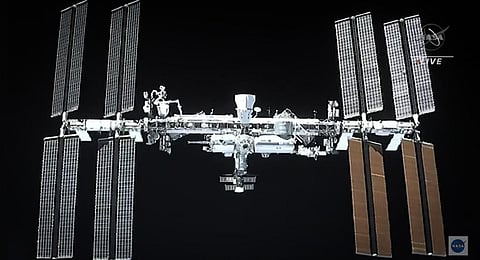

With the successful launch of the Chandrayaan-3 moon mission and solar probe mission Aditya-L1, the Indian Space Research Organisation (ISRO) has set its sights on a human spaceflight programme —sending an Indian astronaut to the International Space Station (ISS) by next year.
This was revealed during the recently concluded bilateral meeting between US President Joe Biden and Narendra Modi on Sept 8, where both sides announced their plan to develop a strategic framework for human space flight by year-end as New Delhi aims to send an Indian astronaut to the ISS in 2024.
In a joint statement released after the bilateral talks, President Biden congratulated Prime Minister Modi and the scientists and engineers of the Indian Space Research Organisation (ISRO) on Chandrayaan-3’s historic landing at the south polar region of the Moon, as well as the successful launch of India’s first solar mission, Aditya L1.
"Determined to deepen our partnership in outer space exploration, ISRO and NASA have commenced discussions on modalities, capacity building, and training for mounting a joint effort to the International Space Station in 2024, and are continuing efforts to finalise a strategic framework for human space flight cooperation by the end of 2023," the joint statement read.
"India and the United States also intend to increase coordination on planetary defence to protect planet Earth and space assets from the impact of asteroids and near-Earth objects, including US support for India's participation in asteroid detection and tracking via the Minor Planet Center," the statement said.
During PM Narendra Modi's US state visit in June, the leaders announced that NASA would provide advanced training to Indian astronauts at Johnson Space Centre in Houston, Texas, with the goal of mounting a joint effort to the ISS. The leaders had celebrated the delivery of the NASA- ISRO Synthetic Aperture Radar (NISAR) satellite to ISRO's UR Rao Satellite Centre in Bengaluru and looked forward to NISAR's 2024 launch from India.
Meanwhile, the ISRO is working toward the 'Gaganyaan Mission' which will launch a crew of three members to an orbit of 400 km for a three-day mission and bring them back safely to earth by landing in Indian seawater. It has been scheduled for late 2024 or early 2025.
The space agency is currently conducting various tests including Air Drop Test, Pad Abort Test and Test Vehicle flights as well as the safety and reliability of all systems for safe ejection and transport during manned missions. The current Launch Vehicle Mark-III (LVM-3) will be modified to become a Human-Rated Launch Vehicle (HRLV), capable of carrying a crew module and astronauts to space.
So far, ISRO has completed Cryo Stage (C25) engine qualification tests, static tests of the Crew Escape System and the integrated main parachute airdrop test. among several other milestones. The test vehicle for the characterization of the Crew Escape System is also made ready at Satish Dhawan Space Centre (SDSC-SHAR). The space agency is also expected to begin testing using the L-40 engine in October.
Keeping human safety paramount, various new technologies comprising engineering systems and human-centric systems are being developed and realised by the ISRO, which initially began working on a human space mission around 2006-07.
In 2007, the space agency conducted the Space Capsule Recovery Experiment (SRE) and achieved success with its thermal shield experiment, which is important for undertaking crewed missions.
In 2009, the govt sanctioned funding but due to an inadequate flow of funds, the human mission was halted. The project was renewed around 2017 with the proposal to demonstrate its human space travel capability by 2021-22. However, the onset of the COVID-19 pandemic had delayed the project.
Notably, former Indian Air Force pilot Rakesh Sharma is the only Indian national to have travelled in space to date. He flew aboard the Soyuz T-11 in April 1984.
Later, two astronauts of Indian origin — Sunita Williams and Raja Chari — have been to the ISS but both were American citizens at the time of their flight.